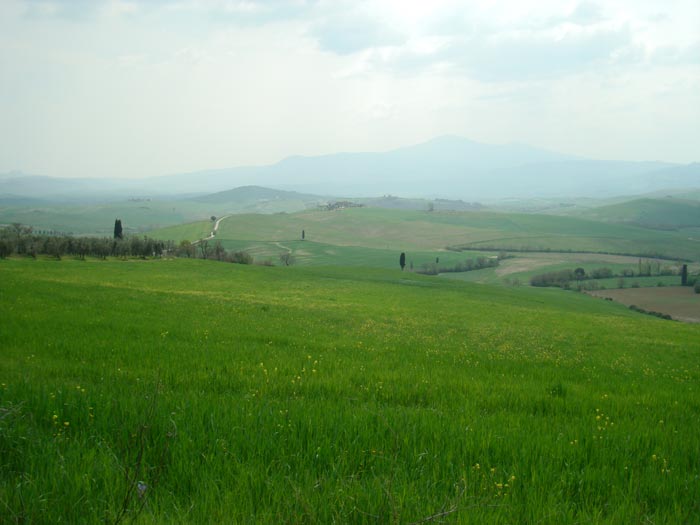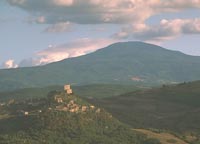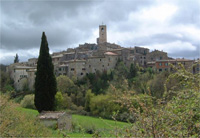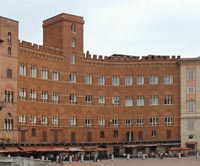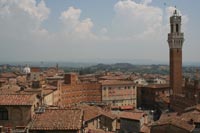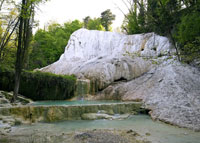Val d'Orcia, between Pienza and Bagno Vignoni
|
|
The Val d’Orcia
|
| The landscape of Val d’Orcia is part of the agricultural hinterland of Siena, redrawn and developed when it was integrated in the territory of the city-state in the 14th and 15th centuries to reflect an idealized model of good governance and to create an aesthetically pleasing picture. The landscape’s distinctive aesthetics, flat chalk plains out of which rise almost conical hills with fortified settlements on top, inspired many artists. Their images have come to exemplify the beauty of well-managed Renaissance agricultural landscapes. The inscription covers: an agrarian and pastoral landscape reflecting innovative land-management systems, towns and villages, farmhouses, and the Roman Via Francigena and its associated abbeys, inns, shrines, bridges, etc.Gently undulating hillside and lush green valleys traversed by the Orcia river and the ancient via Cassia. This is the Val d'Orcia, a place where to admire both the enchanting landscapes and the picturesque towns of the Tuscan countryside. Following the Via Francigena, this itinerary commences in Montalcino, town where the Brunello di Montalcino, one of Italy's most famous wines, is produced. Positioned on the summit of a hill, Montalcino is an ancient town which jealously guards both its artworks and its history. The imposing Rocca di Montalcino, occupying a strategic position overlooking all potential access points, defended the town from attack for centuries. Amidst the narrow roads of the historic center, important works of architecture can be seen. The Church of Sant Egidio and the Church of Sant'Agostino were both built in the 14th century, whilst the cathedral, constructed on the site of an ancient 9th century house of worship, dates back to the neoclassical period. Another masterpiece of religious architecture, the Abbey of Sant Antimo, is situated just a few kilometers from Montalcino. Legend has it that this splendid example of Tuscan Romanesque was built on the site of the votive chapel erected by Charlemagne so as to conserve the relics of Saint Sebastian and Saint Antimo. San Quirico d' Orcia - On the northern edge of Val d'Orcia, San Quirico d'Orcia has grown up on the site of the medieval village of Osenna. In 1256 it became part of Siena's territory, and today it still appears to us with its original medieval street plan. Located in a strategic position along the Via Cassia (and the old Via Francigena), San Quirico d'Orcia was often the residence of imperial bailiffs. In its town centre, encircled by fortified walls, a stop should be made at the Collegiata dei Santi Quirico e Giulitta with its magnificent Romanesque-Gothic doorways as well as at the Misericordia and Santa Maria di Vitaleta churches, at the Palazzo Pretorio (town hall) and at Palazzo Chigi. The Horti Leonini gardens are a splendid example of giardini all'italiana: they were designed in about 1540 by Diomede Leoni and periodically host temporary exhibits of contemporary sculpture. A final stop should be made to admire the Santa Maria Assunta church, the Giardino delle Rose (rose garden) and the centuries-old Scala hospital. Whilst San Quirico d'Orcia is known for its gardens, Bagno Vignoni is famous for the 16th century baths lying at its center and filled with thermal water which arrives at a temperature of 50° directly from the tiny little town's volcanic springs. Known since Roman times, the health inducing properties of Bagno Vignoni's water were apparently much appreciated by none other than Santa Caterina of Siena, to whom the small sanctuary situated directly opposite the baths is dedicated. The symbol of Castiglione d'Orcia is, without doubt, its impressive Rocca degli Aldobrandeschi, stronghold situated in the highest point of the town, and from where a spectacular view of the entire valley can be admired. Castiglione d'Orcia was the birthplace of Lorenzo di Pietro, painter better known by the name of Vecchietta and after whom the town's main square, with unusual cobbled paving and geometric designs, has been named. This itinerary draws to a close in Pienza, the Ideal Renaissance City. When the town's most illustrious citizen, Enea Silvio Piccolomini, became Pope Pius II, he ensured that his birthplace got a serious face-lift, which would respect, to the letter, the canons of renaissance aesthetics. The experiment was a resounding success, and resulted in a stunning trapezoidal piazza, a cathedral by Bernardo Rossellino, and the elegant Palazzo Borgia and Palazzo Piccolomini. Renaissance perfection aside, a trip to Pienza offers visitors the opportunity to stock up on the town's world famous Pecorino cheese, to taste and purchase in the various delicatessens lining the streets of the historic center. Tuscany | The Val d'Orcia |
Tuscany is one of the most popular tourist destinations in the world. Known for its enchanting landscapes, its fantastic and genuine food and beautiful towns as Florence, Pisa, Lucca and Siena. Podere Santa Pia is located in the heart of the green hills of the Valle d'Ombrone, and one can easily reach some of the most beautiful attractions of Tuscany, such as Montalcino, Pienza, Montepulciano and San Quirico d'Orcia, famous for their artistic heritage, wine, olive oil production and gastronomic traditions. Hidden away from mass-tourism, discover a piece of Italy which remains largely unchanged both nature and lifestyle-wise. The peacefulness of the countryside, the various unique villages and the friendly atmosphere will no doubt pleasantly surprise you. Podere Santa Pia is a fully equipped 4 bedroom holiday home. The surrounding countryside is superbly peaceful with vineyards, olive groves, medieval hamlets and castles. Guests can sit in a South facing garden, surrounded by a marvelous natural landscape rich in beautiful hills, ancient villas, centuries-old olive groves, vineyards and hilltop villages with stone parish churches. This is the land where the DOC wines Montecucco and Brunello are produced. So, the surrounding countryside is the ideal area for an uncommon wine tour, visiting small farms producing wine and excellent extra virgin olive oil. Not far from Cinigiano and clearly visible from Podere Santa Pia, is the famous Castle of Poggio alle Mura, also known as Villa Banfi and home to one of the most popular producers of Brunello di Montalcino D.O.C.G. wine. Set in 7100 hectares of land in the Montalcino area, Castello Banfi il Borgo is one of the most important wine producers in Tuscany. The extreme simplicity of Tuscan cuisine is its strongest strength, as the flavours that emerge during the cooking process are vibrant and pure. A little known fact about Tuscan cuisine is that the French learned how to cook from their Tuscan counterparts when it was imported by Catherine de' Medici into the court of Henry II. The Tuscan style of cooking is richly flavoured and wholesome. The 19th Century Kitchen with open fire and wood burning pizza oven, Casa Santa Pia offers an upbeat atmosphere.If you want to spend an unforgettable holiday at Podere Santa Pia and visit these beautiful medieval castles and villages, visit our special offers page or contact us. |
Podere Santa Pia |
Podere Santa Pia |
Rocca di Tentennano |
||
Pienza |
Montalcino |
San Casciano dei Bagni |
||
|
||||
Siena, Palazzo Sansedoni |
Siena, Piazza del Campo |
Bagno San Filippo |
||
|
||||
From San Quirico d'Orcia to Bagno Vignoni |
||||
|
||||
